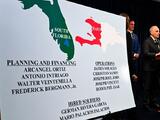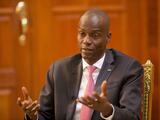The fall of Mexico's 'Supercop' Genaro Garcia Luna. Security chief goes on trial in US for alleged drug cartel ties

Genaro Garcia Luna was billed as a new Supercop who was going to transform the fraught security relationship between Mexico and the United States.
But after some promising collaboration, that U.S. diplomats and law enforcement officials say brought positive results, a different picture began to emerge of Mexico’s former top security chief.
“He liked to present himself as a superhero type of avenging cop. We have to truly admit that he fooled us,” said retired US ambassador John Feeley, who was number two in the US embassy and worked closely with Garcia Luna on implementing the new security agreement, known as the Merida Plan.
“We worked with this guy. All of us were aghast to learn that the Department of Justice had been investigating him,” he told Univision.
Garcia Luna is on trial in New York City on charges he accepted tens of millions of dollars in drug-money bribes from kingpin Joaquin “El Chapo” Guzman’s notorious Sinaloa cartel to let it traffic cocaine with impunity. Jury selection is due to be completed on Thursday with opening statements in the trial scheduled for Monday.
Garcia Luna has denied all charges against him, and the trial is expected to last at least two months.
The trial promises to be deeply embarrassing to both governments, exposing the corruption at the heart of failed efforts to stem the drug trade. The downfall of Garcia Luna symbolized the failure of the Merida Plan that was designed by President Barack Obama to create a more collegial security relationship with Mexico.
Similar to Plan Colombia in Colombia, it was hoped that by greater collaboration and sharing of resources, the two countries would be more effective in confronting the drug trade that was spiraling out of control on the U.S. southern border, turning cities like Ciudad Juarez and Nuevo Laredo into virtual war zones.
Garcia Luna was considered an ally of the DEA
Garcia Luna was not arrested until December 2019, long after he had left Mexico and was living a life of luxury in Miami, seemingly free from suspicion.
“By the time the defendant relocated to the United States in 2012, he had amassed a personal fortune of millions of dollars that was inconsistent with a civil servant’s salary in Mexico,” according to court papers.
In 2021, the Mexican government sued Garcia Luna, and his wife, in Florida court seeking recovery of $250 million in funds allegedly stolen from the Mexican government in illegal contracts while he was Minister of Public Security. The finds were allegedly laundered through a complex web of companies using offshore accounts in Barbados, to acquire luxury apartments, cars and boats in Miami.
Testimony that came out later in the New York trial of El Chapo in 2018 confirmed suspicions that several high-ranking Mexican chiefs of police and military officers were involved in the drug trade.
Jurors heard former cartel member Jesus Zambada testify that he personally made at least $6 million in hidden payments to Garcia Luna, on behalf of his older brother, cartel boss Ismael “El Mayo” Zambada.
The cash was delivered during two meetings at a restaurant in Mexico between 2005 and the end of 2007, he said.
Hand picked by President Calderon
Garcia Luna was viewed as the point man in then-President Felipe Calderon’s 2006-2012 militarized assault on the cartel.
From 2001 to 2005, he led Mexico’s Federal Investigation Agency, and from 2006 to 2012 served as Mexico’s secretary of public security, controlling the nation’s federal police force.
Calderon has defended his government, saying he also had no idea what Garcia Luna was allegedly doing behind his back. But his government was criticized for not going after El Chapo’s Sinaloa cartel with the same energy as the cartel’s rivals.
But U.S. officials reject the notion that they somehow exploited Garcia Luna, turning a blind eye to his corruption. Mike Vigil, a former DEA Chief of International Operations, also recalled a good working relationship with Garcia Luna. “He was very amenable to providing assistance to U.S. agencies, especially the DEA,” Vigil told Univision.
He and others say the Mexican wasn’t always easy to communicate with as he spoke very fast and often mumbled his words. “You really had to pay attention when you were speaking with him,” said Vigil.
It’s unclear when he became dirty, say U.S. officials who worked closely with him. “It’s a great object lesson to show two things. When you partner with a foreign government you don’t get to who you work with,” said Feeley.
“For someone like Garcia Luna we were told by the president, ‘this is my guy.’ So, we had no choice but to work with him,” he added.
Garcia Luna: "visionary institution builder"
"Garcia Luna “was an enormously collaborative and engaged partner” and appeared to be committed to a new “vision” of how to tackle organized crime in Mexico, another former senior U.S. official told Univision. “His effort to reform the police was impressive. He was a visionary institution builder,” the former official said.
U.S. officials credit Garcia Luna with setting up an entirely new investigative branch from scratch, the Public Security Office, modeled on the FBI.
It was Mexico’s first, effective national level police force, with a database that was able to quickly trace car license plates and conduct discreet, undercover investigations.
That included a brand new forensics laboratory staffed by a new cadre of young, college educated agents. Garcia Luna invited in trainers from the FBI, as well as the U.S. Bureau of Prisons.
Vigil recalls visiting a command center, known as the 'Bunker', where specially trained Mexican units worked on kidnapping cases and tracking inbound and outbound planes suspected of carrying drugs. “They were creating something very special,” said Vigil.
There were occasional red flags, official say, that worried them. One officials described an incident when the U.S. embassy got a tip from a highly trusted source that Garcia Luna was “on the take” from one of the cartels.
Garcia Luna brushed off the allegations and no proof emerged until much later.
Garcia Luna lived in a large house in Mexico City and made the best of a lavish government budget for entertainment. But the word was that he had married well and that his wealth came from his wife’s side of the family.
In fact, U.S. government prosecutors allege that for nearly two decades, Garcia Luna and members of his inner circle took bribes from members of the Sinaloa cartel, to protect their drug shipments and providing tips about potential arrests and investigations into the cartel.
Back then - and still today - US officials confess its often hard to tell the difference between the good cops and the bad cops, in the shady world of drug deals and confidential informants who are themselves often suspects or indicted criminals.
“It’s a sewer,” said Feeley.



